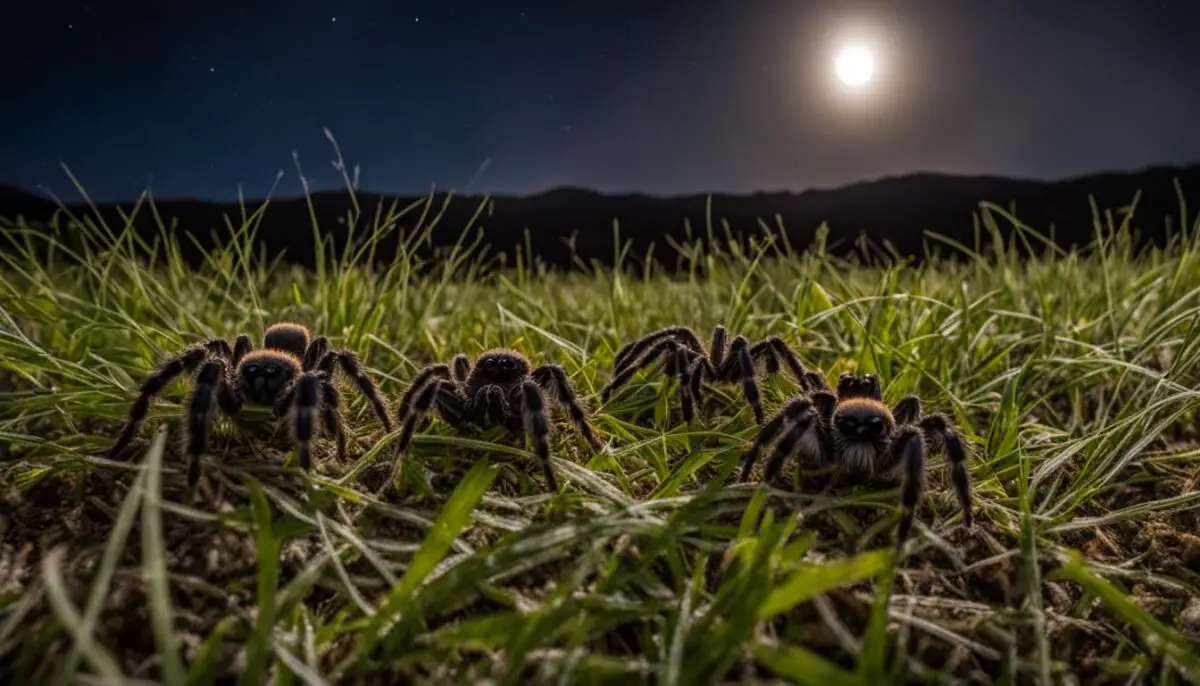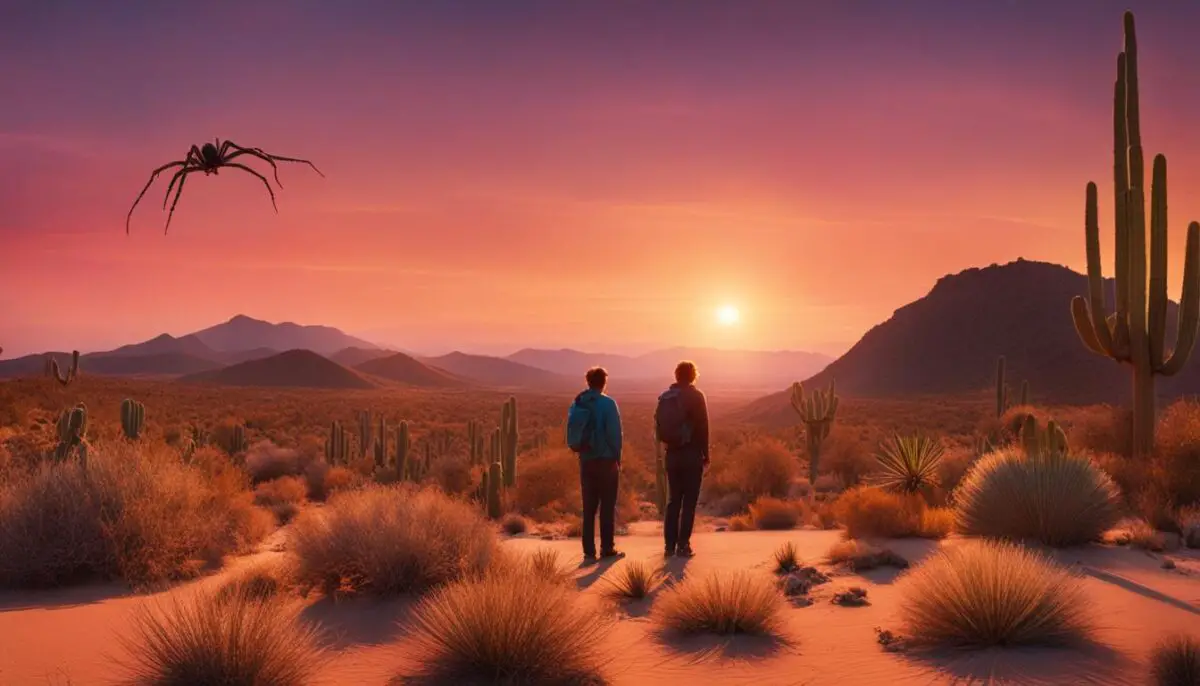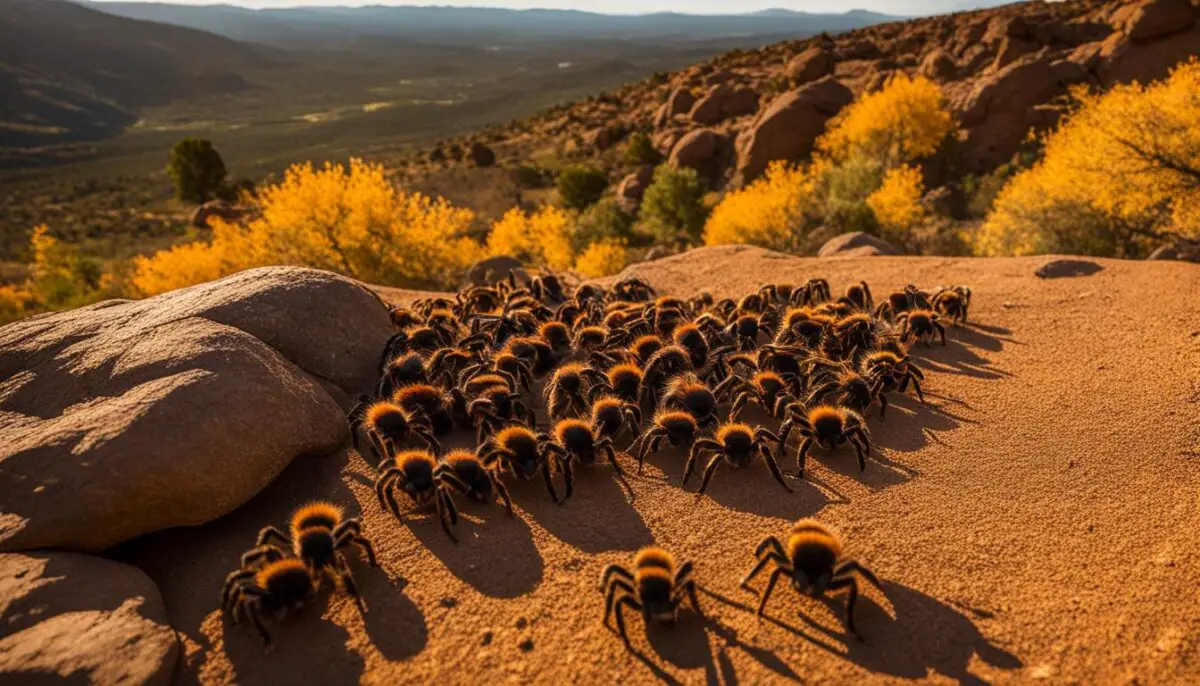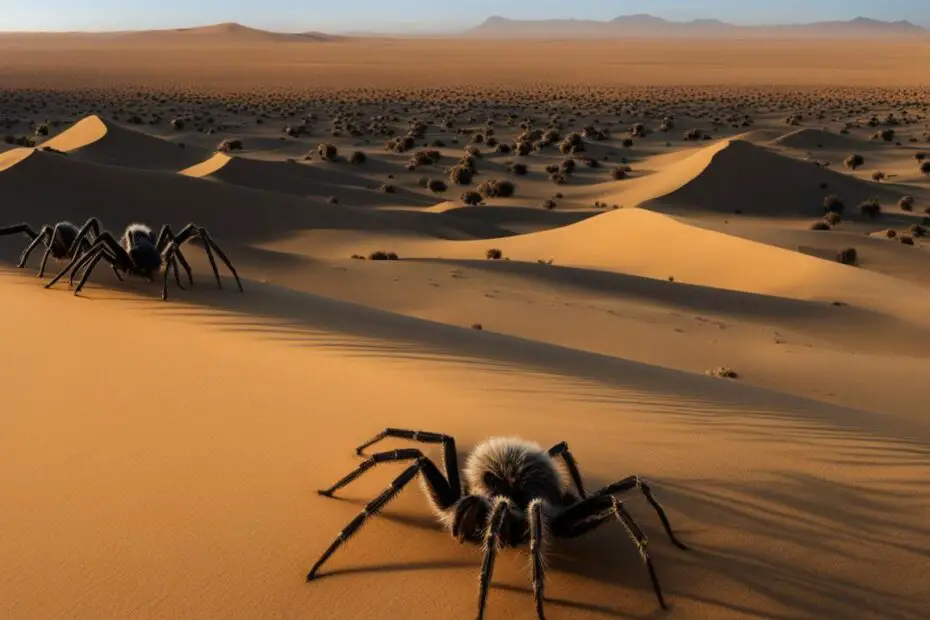Every September and October, male Oklahoma brown tarantulas in Southeastern Colorado embark on a quest for love. This journey, known as a “mategration,” takes place when the nights turn chilly but before hard freezes begin. Tarantula experts from Butterfly Pavilion describe the migration as a fascinating natural spectacle and an emerging tourism opportunity.
Key Takeaways:
- Tarantula migration in Colorado occurs in September and October.
- Male tarantulas undertake a journey to find female burrows during their migration.
- Observing tarantula migration can be a unique and educational experience.
- Tarantula migration in Colorado has contributed to the development of tarantula tourism.
- Understanding tarantula migration patterns and behaviors is crucial for their conservation.
When Do Tarantulas Migrate in Colorado
The Journey of Male Tarantulas in Colorado
| Migration Patterns | Migration Timing |
|---|---|
| Tarantulas undertake a migration of 20 to 100 meters each evening | Migration typically happens in September and October |
Male tarantulas in Colorado embark on a fascinating journey each year in search of female burrows. These migrations cover a distance of 20 to 100 meters each evening, as males tirelessly traverse the landscape in their quest for love. It takes males between seven and 10 years, and females 10 to 12 years, to reach reproductive readiness, making the migration a highly anticipated event for these remarkable creatures. tarantulas migration season colorado
The migration of tarantulas in Colorado typically occurs in September and October, providing a unique opportunity for visitors to witness this natural spectacle. As the nights turn chilly but before hard freezes begin, the male tarantulas set out on their annual migration. This phenomenon has sparked increasing interest among nature enthusiasts and wildlife lovers, who gather to observe and learn more about the behavior and migration patterns of these fascinating arachnids.
During the migration, male tarantulas are seen moving in search of female burrows, creating a captivating sight. Their journey offers a glimpse into the extraordinary life cycle of these spiders and the lengths they go to ensure their survival and reproduction. With their distinct patterns and behavior, tarantulas in Colorado provide a unique and engaging experience for those lucky enough to witness their migration. tarantula migration timing
The Mating Ritual of Tarantulas
During the tarantula migration season in Colorado, observing the mating ritual of these fascinating creatures is a thrilling experience. Once a male tarantula finds a female’s burrow, he will stand outside and drum his pedipalps, which are specialized appendages near his mouth. This behavior serves as a courtship display to signal his intentions. If the female is receptive, she will emerge from her burrow, and the two spiders will engage in a quick coupling. colorado tarantula migration information
However, the mating process is not without risks for the male tarantulas. Approximately one-third of female tarantulas strike at their potential mates, with about 20 percent of these encounters resulting in the male’s death. Despite the danger, the males persist in their quest for love and continue to search for receptive females.
“The courtship and mating behaviors of tarantulas are truly remarkable,” says Dr. Emily Arachnid, a renowned arachnologist. “The drumming signals and the intricate interactions between males and females offer valuable insights into the reproductive strategies of these impressive spiders.”
Spotting tarantulas engaged in their mating ritual during the migration season requires patience and careful observation. Visitors to areas where tarantulas migrate can witness this natural spectacle up close and gain a deeper appreciation for the complex behaviors and adaptations of these arachnids.
| Benefits of Observing Tarantula Mating Rituals | Tips for Spotting Tarantulas during Migration Season |
|---|---|
|
|
The Mating Ritual of Tarantulas
Tarantula Diet and Predators
During their migration in Colorado, tarantulas face various challenges, including finding food and avoiding predators. Tarantulas primarily feed on beetles, grasshoppers, crickets, and other small insects, which make up their main diet. These spiders have a unique ability to ambush and capture their prey, using their powerful fangs to inject venom and immobilize their victims. tarantula migration patterns colorado
However, tarantulas themselves are not exempt from being hunted. They must navigate their migration routes while evading potential predators such as coyotes, foxes, snakes, certain birds, and even a wasp species known as tarantula hawks. Tarantula hawks lay their eggs inside tarantulas, which serve as a food source for their developing larvae. It’s a brutal cycle of predator and prey. annual tarantula migration in colorado
In order to understand the migration patterns of tarantulas in Colorado, it is crucial to study their diet and predators. By gathering data on their food sources and the threats they face, scientists can gain valuable insights into their behaviors and survival strategies. tarantula migration routes in colorado
| Tarantula Diet | Predators |
|---|---|
| Beetles | Coyotes |
| Grasshoppers | Foxes |
| Crickets | Snakes |
| Other small insects | Birds |
Understanding the complex interactions between tarantulas, their prey, and their predators is essential in preserving their populations and their crucial role in the ecosystem. By studying their migration routes and the challenges they face along the way, researchers can gain a deeper understanding of these fascinating creatures and work towards their conservation.
Mysteries Surrounding Tarantulas
Despite research efforts, there are still many mysteries surrounding tarantulas in Colorado. Arachnologists have made significant progress in understanding these fascinating creatures, but there are still unanswered questions. Let’s explore some of the mysteries surrounding tarantulas and their migration in Colorado.
Survival in Sub-Freezing Temperatures
One of the biggest mysteries is how tarantulas survive sub-freezing temperatures during their migration. These spiders are cold-blooded, meaning their body temperature is reliant on the environment. With temperatures dropping significantly, it remains unclear how tarantulas manage to stay alive. Researchers believe that they may seek shelter in protective burrows or utilize physiological adaptations to withstand the cold.
Navigating Spring Floods
Another mystery is how tarantulas navigate through spring floods, which are common in Colorado. These floods can drastically alter the landscape, including the routes and habitats that tarantulas rely on during their migration. It is not fully understood how these creatures are able to adapt and find their way through the changing environment, especially considering their relatively poor eyesight.
Oklahoma Brown Adaptations
The specific adaptations of Oklahoma brown tarantulas to the harsh climate in southeastern Colorado are also not fully understood. These tarantulas have managed to thrive in a region known for its extreme temperature fluctuations and arid conditions. Scientists continue to study the unique physiological and behavioral adaptations that enable these spiders to survive and reproduce successfully in their challenging environment.
| Unanswered Questions | Possible Explanations |
|---|---|
| How do tarantulas survive sub-freezing temperatures? | Seeking shelter in burrows or utilizing physiological adaptations. |
| How do tarantulas navigate through spring floods? | Utilizing unknown cues or adaptability to changing environments. |
| What are the specific adaptations of Oklahoma browns to southeastern Colorado? | Unique physiological and behavioral traits developed over time. |
These mysteries surrounding tarantulas in Colorado add to the allure and intrigue of these creatures. As research and conservation efforts continue, we hope to unravel these enigmatic secrets and gain a deeper understanding of tarantulas’ remarkable abilities and adaptations.
Tarantula Tourism in Colorado
The annual tarantula migration has become a tourism opportunity in Colorado, attracting visitors from near and far. The town of La Junta has been promoting the Tarantula Trek since 2018, and events such as the Tarantula Fest have been added to the lineup. These initiatives have had a positive impact on the local economy and also serve as educational tools to raise awareness about tarantulas and their role in the ecosystem.
Colorado’s unique tarantula migration season provides a thrilling experience for nature enthusiasts and curious onlookers. Witnessing the annual male tarantula migration in search of female burrows is a sight worth traveling for. The best time to see tarantulas in Colorado is during September and October, when the migration takes place.
During this time, the town of La Junta and surrounding areas become hotspots for tarantula sightings. Visitors can take part in guided tours, hikes, and special events dedicated to observing and learning about these fascinating creatures. Tarantula Fest, in particular, offers a range of activities for all ages, including tarantula-themed crafts, educational sessions, and opportunities to see live tarantulas up close.
With its growing popularity, tarantula tourism in Colorado not only provides entertainment and adventure but also supports local businesses and conservation efforts. The revenue generated from tourism helps fund research and conservation projects aimed at protecting these remarkable spiders and their habitats. So if you’re looking for a unique and thrilling wildlife experience, plan a trip to Colorado during the tarantula migration season and be prepared to be mesmerized by nature’s fascinating spectacle.

Table: Tarantula Tourism Events in Colorado
| Event | Date | Location |
|---|---|---|
| Tarantula Trek | September-October | La Junta |
| Tarantula Fest | September | La Junta |
Tips for Spotting Tarantulas
To increase your chances of spotting tarantulas during their migration season, it is recommended to visit areas away from major roadways where the spiders are more active. Dusk is the best time to observe them, as they are most active during this period. It is important to remember that tarantulas are docile creatures but should still be observed from a safe distance to avoid stressing them or getting their urticating hairs stuck in your skin.
To ensure a successful tarantula-spotting adventure, here are some tips:
- Choose the right location: Head to areas known for tarantula migration, such as highways 10, 350, and 109 south of La Junta, Vogel Canyon, Sierra Vista, and the Comanche National Grassland.
- Timing is key: Plan your visit during September and October, which is when the tarantula migration typically takes place.
- Be patient: It may take some time to spot tarantulas, so bring binoculars or a camera with a zoom lens to enhance your chances of observing them from a distance.
- Respect their space: While tarantulas are generally harmless, it is important not to disturb them or their environment. Observe them quietly and avoid touching or handling them.
Remember, seeing tarantulas in their natural habitat is a unique and remarkable experience. By following these tips, you can increase your chances of witnessing this fascinating natural phenomenon while ensuring the well-being of these incredible creatures.
Table: Colorado Tarantula Migration Tips
| Tip | Description |
|---|---|
| Choose the right location | Visit areas away from major roadways known for tarantula migration, such as highways 10, 350, and 109 south of La Junta, Vogel Canyon, Sierra Vista, and the Comanche National Grassland. |
| Timing is key | Plan your visit during September and October, which is when the tarantula migration typically takes place. |
| Be patient | Bring binoculars or a camera with a zoom lens to enhance your chances of observing tarantulas from a distance. It may take some time to spot them. |
| Respect their space | Observe tarantulas quietly and avoid touching or handling them. They are generally harmless but should be left undisturbed. |
By following these tips and respecting these fascinating creatures, you can have a memorable and educational experience observing tarantulas during their migration season in Colorado.
Spider-Spotting Hikes in Colorado
If you’re eager to witness the fascinating tarantula migration in Colorado, there are several hiking trails that offer excellent opportunities for spider spotting. These trails not only allow you to observe these impressive creatures but also provide a chance to immerse yourself in the stunning landscapes of the region.
One recommended trail for tarantula sightings is the Timpas Picnic Area Nature Trail. Located in Southeastern Colorado, this trail offers a tranquil setting where you can be on the lookout for migratory tarantulas. Another notable option is the Prairie Trail in Vogel Canyon, which is known for its spider-sighting potential.
For those who are up for a more adventurous trek, the Picket Wire Trail in the Picket Wire Canyonlands is a great choice. This trail boasts not only breathtaking views but also a higher likelihood of spotting tarantulas during their migration season. So, get your hiking gear ready and embark on an exciting journey to witness this natural phenomenon in action.
| Hiking Trail | Location | Tarantula-Sighting Potential |
|---|---|---|
| Timpas Picnic Area Nature Trail | Southeastern Colorado | High |
| Prairie Trail in Vogel Canyon | Vogel Canyon | Medium |
| Picket Wire Trail | Picket Wire Canyonlands | High |
Tarantula-Sighting Potential
- High: These trails offer a greater likelihood of spotting migratory tarantulas in Colorado.
- Medium: These trails have a moderate potential for tarantula sightings during the migration season.
- Low: Trails in this category may have some tarantula activity, but the chances of sightings are relatively lower.
Remember to exercise caution and respect for these fascinating creatures during your hike. Keep a safe distance, avoid disturbing them, and enjoy the awe-inspiring beauty of both the tarantulas and the natural surroundings.
Tarantula Viewing Locations in Colorado
Colorado offers a variety of prime locations for witnessing the mesmerizing tarantula migration. These areas provide suitable habitats for the spiders and offer visitors the opportunity to observe their unique behaviors.
Highways 10, 350, and 109 South of La Junta
One of the best places to see tarantulas in Colorado is along highways 10, 350, and 109, located south of La Junta. These routes have been known to have a higher concentration of tarantulas during their migration season. Visitors can drive along these highways and keep a lookout for the spiders crossing the road or exploring the surrounding landscapes.
Vogel Canyon and Sierra Vista
Vogel Canyon and Sierra Vista are two other recommended locations for tarantula viewing. These picturesque areas provide a natural setting where tarantulas can be spotted during their migration. Visitors can enjoy the beauty of the landscapes while keeping an eye out for these fascinating creatures.
Comanche National Grassland
The Comanche National Grassland is a popular spot for tarantula viewing in Colorado. Its wide open spaces and diverse ecosystems make it an ideal habitat for tarantulas. Visitors can explore the grassland while observing the spiders’ migration and mating rituals.

| Location | Features |
|---|---|
| Highways 10, 350, and 109 | Frequently crossed by tarantulas during migration season |
| Vogel Canyon | Scenic location with tarantula sighting potential |
| Sierra Vista | Natural setting ideal for observing tarantulas |
| Comanche National Grassland | Diverse ecosystem and open spaces perfect for tarantula viewing |
Tarantula Migration Phenomenon
Contrary to popular misconceptions, the tarantula migration in Colorado does not involve thousands of spiders marching across the landscape. Instead, it is more common to see a handful or a few at a time. The migration is a unique natural phenomenon that offers a glimpse into the fascinating behavior of these creatures and their role in the ecosystem.
During their migration, male tarantulas in Colorado travel a distance of 20 to 100 meters each evening in search of female burrows. This annual migration, which takes place in September and October, is a long-awaited event for the spiders as they actively seek out potential mates. Although the migration may not involve large numbers of tarantulas, it still showcases their remarkable instincts and survival strategies.
Tarantulas primarily feed on beetles, grasshoppers, crickets, and other small insects, but during their migration, they must also navigate through potential predators. Coyotes, foxes, snakes, certain birds, and tarantula hawks pose a threat to these spiders. This intricate interplay between tarantulas and their environment highlights the delicate balance of nature and the importance of understanding their migration patterns and habitat requirements.
The tarantula migration phenomenon in Colorado is a captivating natural spectacle that provides insights into the behavior and ecology of these intriguing arachnids. By observing and studying their migration patterns, researchers can further unravel the mysteries surrounding tarantulas and contribute to their conservation and protection.

| Tarantula Migration Patterns | Tarantula Migration Routes |
|---|---|
| Tarantulas migrate in September and October | Highways 10, 350, and 109 south of La Junta |
| Males travel 20-100 meters each evening | Vogel Canyon and Sierra Vista |
| Males search for female burrows | Comanche National Grassland |
Tarantulas and Ecotourism
Observing tarantula migration in Colorado and exploring tarantula migration routes has become an increasingly popular activity for both tourists and nature enthusiasts. The unique spectacle of these giant spiders on the move attracts visitors from near and far, and local communities have embraced this phenomenon as an opportunity for ecotourism.
The town of La Junta, in particular, has taken the lead in promoting tarantula-related tourism. The annual Tarantula Fest, organized since 2018, has become a major attraction for visitors interested in witnessing the migration firsthand. This event not only provides entertainment and educational activities but also highlights the importance of tarantulas and their conservation.
Ecotourism initiatives focused on tarantulas help raise awareness about these fascinating creatures and their ecological significance. By observing tarantulas during their migration, visitors gain a deeper understanding of their behavior, habitat, and role in the local ecosystem. This knowledge contributes to the overall conservation efforts aimed at preserving these intriguing arachnids and their natural habitats.
Table: Tarantula Fest Events
| Date | Event |
|---|---|
| September 15 | Tarantula Parade |
| September 16 | Tarantula Art Exhibition |
| September 17 | Tarantula Educational Workshops |
| September 18 | Tarantula Night Hike |
| September 19 | Tarantula Photography Contest |
These ecotourism initiatives not only benefit the local economy but also foster a sense of environmental stewardship. By sharing knowledge about tarantulas and encouraging their protection, communities and visitors alike contribute to the long-term preservation of these fascinating creatures and the delicate balance of Colorado’s ecosystems.

Conclusion
The migration of tarantulas in Colorado is a captivating natural phenomenon that occurs each year in September and October. Male tarantulas embark on a journey to find female burrows, engaging in courtship behaviors and risking their lives in the pursuit of love.
Tarantula migration offers opportunities for observation, education, and ecotourism, contributing to the conservation and appreciation of these remarkable spiders. The annual migration has become a tourism opportunity in Colorado, attracting visitors from near and far. Initiatives like the Tarantula Trek and Tarantula Fest have had a positive impact on the local economy while also serving as educational tools to raise awareness about tarantulas and their role in the ecosystem.
By highlighting tarantulas’ ecological roles and their unique adaptation to the Colorado landscape, ecotourism efforts contribute to the overall understanding and preservation of these intriguing arachnids. So, if you’re wondering when do tarantulas migrate in Colorado, mark your calendar for September and October and get ready to witness this fascinating natural spectacle!
FAQ
When do tarantulas migrate in Colorado?
Tarantulas in Colorado migrate in September and October.
What is the journey of male tarantulas in Colorado?
Male tarantulas migrate 20 to 100 meters each evening in search of female burrows.
How can I spot tarantulas during their migration season in Colorado?
It is recommended to visit areas away from major roadways where tarantulas are more active, and dusk is the best time to observe them.
What is the diet of tarantulas and what are their predators?
Tarantulas primarily feed on beetles, grasshoppers, crickets, and other small insects. Their predators include coyotes, foxes, snakes, certain birds, and tarantula hawks.
What mysteries surround tarantulas?
Scientists are still unsure how tarantulas survive sub-freezing temperatures and navigate through spring floods. The specific adaptations of Oklahoma browns to the harsh climate in southeastern Colorado are also not fully understood.
Is tarantula migration in Colorado a tourism opportunity?
Yes, tarantula migration in Colorado has become a tourism opportunity, attracting visitors from near and far.
What are some tips for spotting tarantulas?
To increase your chances of spotting tarantulas, visit areas away from major roadways, observe them during dusk, and maintain a safe distance to avoid stressing them.
Are there any hiking trails in Colorado known for tarantula sightings?
Yes, the Timpas Picnic Area Nature Trail, Prairie Tail in Vogel Canyon, and Picket Wire Trail in the Picket Wire Canyonlands are recommended for tarantula sightings.
Where are the best locations to see tarantulas in Colorado?
Highways 10, 350, and 109 south of La Junta, Vogel Canyon, Sierra Vista, and the Comanche National Grassland are popular spots for tarantula viewing.
How many tarantulas can be seen during the migration?
Contrary to popular misconceptions, it is more common to see a handful or a few tarantulas at a time during the migration.
How does tarantula-related tourism contribute to tarantula conservation?
Tarantula-related tourism serves as a platform for educating the public and raising awareness about the importance of tarantulas and their conservation.
Is there a conclusion to this article?
No, this article does not have a conclusion.


Fantastic beat ! I would like to apprentice at the same time as you amend your site, how can i subscribe for a blog website? The account aided me a appropriate deal. I have been tiny bit familiar of this your broadcast offered bright clear concept